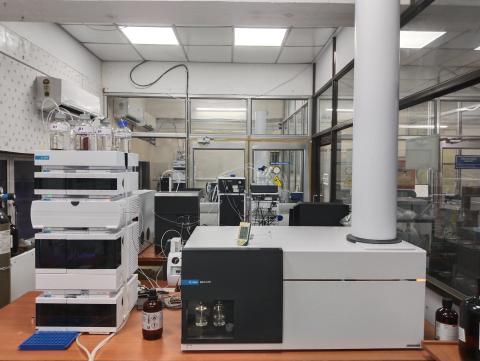
.
Category
- Spectroscopy and Spectrometry » Mass Spectrometry
- Chromatography » Liquid Chromatography
Booking Details
Facility Management Team and Location
Facility Features, Working Principle and Specifications
Facility Description
Liquid chromatography / Mass Spectroscopy (LC / MS) is a technique which combines high performance liquid chromatography HPLC, a powerful analytical separation technique with mass spectroscopy ,a powerful analysis & detection technique.
There are two common atmospheric pressure ionization (API) LC/MS process: Electrospray Ionization (ESI) & Atmospheric Pressure Chemical Ionization (APCI). Both are soft ionization technique.
Agilent iFunnel technology combines highly efficient electrospray ion generation and focusing of Agilent Jet Stream technology with a hexabore capillary sampling array and dual-stage ion funnel for increased ion sampling and transmission.
HPLC combined with mass spectrometer can analysed small molecule as well large molecules like proteins.
Mass spectrometry is an analytical technique that can provide both qualitative (structure) and quantitative (molecular mass or concentration) information on analyte molecules after their conversion to ions. The molecules of interest are first introduced into the ionisation source of the mass spectrometer, where they are first ionised to acquire positive or negative charges. The ions then travel through the mass analyser and arrive at different parts of the detector according to their mass/charge (m/z) ratio. After the ions make contact with the detector, useable signals are generated and recorded by a computer system. The computer displays the signals graphically as a mass spectrum showing the relative abundance of the signals according to their m/z ratio.
Specification
- Mass Range :50-3200 amu
- Mass resolving power: Greater than 45 ,000 FWHM at m/z 2,722
- Mass accuracy – MS mode: Less than 0.8 ppm RMS
- Mass accuracy – MS/MS mode: Less than 2 ppm RMS
- Mass accuracy temperature stability: Maintain 1 ppm mass accuracy (variations < 3 °C from calibration temperature)
- Sensitivity-MS mode (1 pg. Reserpine): 500: 1 RMS
- Sensitivity, MS/MS mode (1 pg. Reserpine): 1,500:1 RMS
- Direct Infusion for Mass Analysis (MS, MS /MS)
- Spectral acquisition rate, MS mode: 50 spectra/second
- Spectral acquisition rate, MS/MS mode: 30 MS/MS spectra/second
Instructions for Registration, Sample Preparation, User Instructions and Precautionary Measures
- External Users can come in-person or send your samples along with a letter from the Head / Guide on your College/Institute /Industry Original Letter Head for registration stating that the analysis is for research purpose to qualify for academic concession.
- The analytical data / spectra are provided only for research / development purposes. These cannot be used as certificates in legal disputes.
- Service charges are payable at prevailing rates.
- Samples, letter and payment should be sent in the same cover only. If Samples are received without covering letter/DD, the samples will be sent back to the user without any further intimation/notice. Separate Sample should be sent for different analysis.
- Samples are not analysed till Payment is received.
- Please send the samples in quantity as mentioned. Samples are not recovered, unless a special request is made.
- Radio -active material should be clearly mentioned and handed over personally.
- Unstable and explosive compounds are not accepted for analysis.
Instructions for sample preparation / submission
- Sample should be pure and dry and submit in a vial along with the sample code, molecular formula or molecular weight.
- Mention the suitable solvent (preferably protonated solvent like MeOH, ACN or water)
User Instructions:
1. Expected structure or mass can be provided.
2. Solvent for mobile phase should be mentioned or solubility of compound in volatile solvent.
3. As HP-LC is available in most departments, LC of submitted samples indicating the operation should be supplied along with the sample.
4. For HPLC DAD analysis, wavelength should be given.
5. MS-DS (Material Safety Data Sheet) should be given along with samples to ensure that their sample being given. Samples should not be toxic or hazardous. Samples will not be accepted unless MS-DS.
Charges for Analytical Services in Different Categories
Charges for external users: (a) Basic charges + (b) GST*
a. Basic charges:
Type of analysis | IITB users (in ₹) | Academic institutes (in ₹) | National R&D lab`s (in ₹) | Industries / Non-Govt. Agencies (in ₹) |
| Charges per sample for Accurate Mass (HRMS) | 10 | 750 | 1500 | 3000 |
| Charges for long experiments per sample (LCMS/MSMS) per hour | 200 | 1000 | 2500 | 5000 |
b. GST*(rate as on 1.8.2017):
1) If the recipient of the report is from Maharashtra: 9% SGST and 9% CGST
2) If the recipient of the report is from outside Maharashtra: 18% IGST
- Payment Terms: 100% Advance
Payment Bank Details for Electronic Transfer:
Account Name: Indian Institute of Technology
Bombay Bank Name: State Bank of India, IIT Powai Branch, Mumbai-400076, India
Account Number: 10725729173
IFSC Code: SBIN0001109
MICR Code: 400002034 Branch Code: 1109
SWIFT Code: SBININBB519
Bank Contact Number: +91-22-2572-1103
Applications
- Qualitative Analysis & Quantitative Analysis.
- Proteins/Peptides:
In-depth qualitative analysis of complex samples.
Intact mass measurement.
- Small Molecules:
Identification and Characterization.
Metabolite analysis: targeted and non-targeted approaches.
Sample Details
MeoH, ACN, Water only
No
